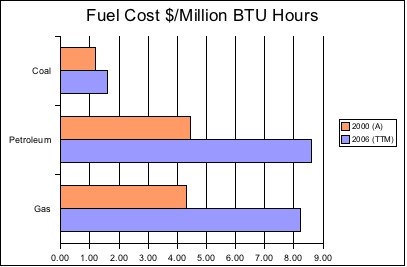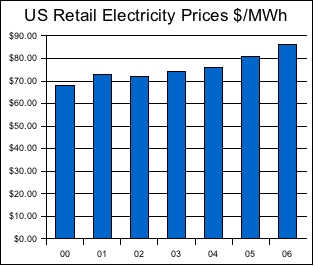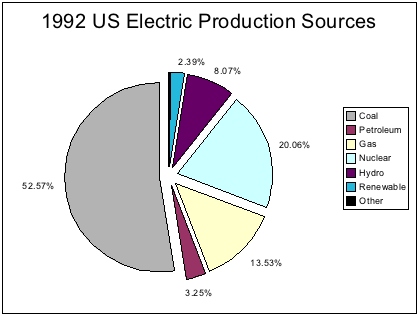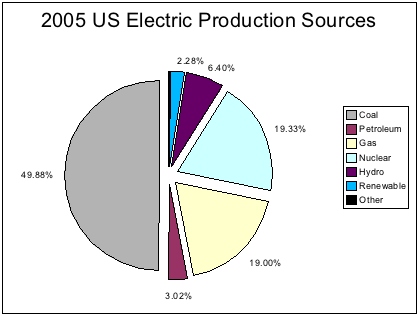Archive for October, 2006
What is renewable energy?
That’s a question I’ve gotten routinely. Here’s the “official” definition from the US Government used to purchase renewable energy:
Executive Order 13323: Renewable energy is energy produced from biomass, geothermal, solar, and wind sources.
Practically speaking, renewable energy is energy whose source is not destroyed when harnessed. The principal renewable energy sources in use today are:
- Hydro: Harnesses water action (gravity, tides, etc.)
- Solar Thermal: Harnesses the Sun’s heat
- Solar Photovoltaic: Harnesses the Sun’s photons
- Wind: Harnesses wind currents
- Geothermal: Harnesses the heat of the Earth
- Biomass: Harnesses photosynthesis process
Each of these sources has a number of different technologies associated with their capture and translation to energy in our society. For instance, in the wind case, wind energy is translated to mechanical energy by physically turning a shaft. That shaft in turn is connected to a generator which translates the mechanical energy into electrical energy. Wind energy has one huge advantage over say, natural gas fired electricity generation: Wind is free. That economic benefit can’t help but assert itself as fossil fuels become more scarce and more expensive.
Besides not destroying the source of the energy, renewable energy sources often have other benefits like low levels pollutants emitted into the atmosphere. Renewable energy is also termed sustainable because of its unique properties. The renewable energy sources exist, the technologies to harness these sources exist, therefore there is little reason not to pursue renewable energy both for electricity generation and for transportation.
Technorati Tags: Renewable | Energy | Sources
What is the best homeland security?
Energy independence.
It’s that simple. Every $ sent to foreign entities (and perhaps some domestic entities with international interests) provides a small bit of leverage in the way we project ourselves as a nation on the globe. As George Washington stated in 1796, “Nations have interests, not friends.” Those $ sent offshore do little to advance our interests; often these $ fund activities diametrically opposed to our interests. Where did Osama bin Laden’s money come from? In part, your energy $.
The technology exists today to harness renewable energy of all types to generate electricity and for use in transportation. These are no longer wacky hippie projects, these are serious commercial enterprises intended to make a profit. And profit they will when we as a nation wake up and assert our will to keep our energy $ at home and become as independent as possible.
How? you might ask. Fair enough, by making choices. Instead of investing to build a new 250MW Gas-fired electricity generation facility, choose to install a 250MW wind farm. Instead of having a useless “middle grade” gasoline, offer E85. Instead of spending billions and billions on failed programs (i.e., Department of Homeland Security) redirect that funding to create more efficient renewable energy technologies. We must only find the will to make the change in our thinking, our decisions, and our priorities.
Technorati Tags: Energy | Policy | Security
What is the environmental cost of a Megawatt hour?
In previous entries we’ve discussed how much electricity the US is producing and consuming, what the sources of generation are, and how much it costs from a monetary perspective. But there are other costs.
This entry will focus on the largest fuel source for electricity generation, coal. This is an ancient source that is well understood and drives a massive supply chain from real estate with mineral rights clear through mining and transportation and finally ending up in places like electricity generation. Without a doubt the technology for oxidizing (burning) coal to create heat which in turn is transferred to liquids which through phase change from liquid to gas pressurize and then drive turbines attached to generators, has improved dramatically. Back during the early days of the industrial revolution cities like Pittsburgh were covered in smog and soot.
The state of the art today is that approximately 1,000 kg (~2,200 lbs) of carbon dioxide and approximately 13kg of sulfur dioxide and nitrogen oxides are emitted into the atmosphere for each MWh of power generated by burning coal. As is well known, carbon dioxide is a major contributor to global warming and the sulfur and nitrogen oxides are key ingredients to acid rain. This level of emissions is a vast improvement from the late 19th century, but still constitutes a problem. With 5% of the population of the earth, the US is responsible for 23% of carbon dioxide emissions on the planet (not just electricity generation, transportation has alot to do with that number as well.) (Source: US Environmental Protection Agency.)
One of the key challenges in limiting emissions is the increasing demand for electricity. Right now, the demand is outstripping the new cleaner generation technology’s installation rate which means that older, less efficient, more polluting coal generation plants are staying in production longer than is desirable. Each time a new technology (be it natural gas or photovoltaics) is deployed, it either meets new demand or displaces older, less cost effective generation technologies. Given the increasing cost of fossil fuels, there is an opportunity to focus our attention more completely on the installation of renewable electric generation at a scale that makes the economics attractive in addition to exceeding the growth in electricity demand. That could have the effect of displacing less effective generation technologies and as a side effect, limit harmful emissions.
Technorati Tags: Energy | Pollution | Emissions
Fossil fuel costs for electric generation

Data based on Electric Power Monthly Report
As you can see from the graph above, fuel prices have increased rather dramatically for petroleum and natural gas over the past 6 years. It is worth noting that the 2000 numbers are actual average prices (A) and the 2006 numbers are a trailing twelve month average (TTM.) Even coal, not known for price volatility has increased in price 35% during this time period. Petroleum and gas have increased 95% and 91% respectively in the same time period. As previously noted in this entry, coal, petroleum, and gas accounted for 72% of electric power generation in 2005 with coal accounting for the large majority of generation. Gas accounts for 19% of total generation, up 84% from 1992. Petroleum accounts for 3% of generation.
A fair question would be, what has happened to retail prices of electricity during this same period?

Data based on Electric Power Monthly Report
As you can see, retail prices have increased during this same time period, but not close to the rate of increase of fossil fuel cost. Does this mean electric generation companies are going out of business? Rising costs without a commensurate increase in end product cost tends to affect profit in a negative way. One thing is certain, it will be challenging to maintain a competitive business model when fuel costs are a major component of the cost of goods sold. Couple that with increasing regulatory pressures over emissions from oxidizing such fuels setup an interesting challenge for the power generation industry.
Technorati Tags: Electricity | Fossil Fuel | Energy Cost
How does the US Produce electricity?
The answer is pretty straightforward, Coal, Liquid Petroleum, Petroleum Gases, Nuclear, Other, and Renewable (water, wind, sun, and biomass.) Of the renewable, water, or hydroelectric, is large enough to rate its own category. The reality of the situation is that in 1992 about 70% of our power was generated using fossil fuels, about 20% was generated using nuclear fuels, about 8% was generated using hydro, and everything else accounted for the remaining 2%. The absolute numbers for generation accounted for 3.08 Petawatt hours (PWh) at this time. See the chart below for a visual representation.

             Â
Data based on Electric Power Monthly Report
Flash forward 13 years to 2005. One might think that things have changed a great deal, but that’s not really the case. Look at the chart below to see the relative % of electricity generation by fuel source.

             Â
Data based on Electric Power Monthly Report
Our dependance on fossil fuels increased to 72%, with gas generation accounting for a large relative increase in % basis, but coal production on an absolute numbers basis increasing hugely as well from 1.62 PWh in 1992 to 2.01 PWh in 2005. Meanwhile, despite the fact that absolute PWhs increased for nuclear, hydro, and other renewables, the growth rate was insufficient to stave off a relative percentage share drop for each of these fuels with a relative change of -4% for nuclear fuel share, -21% for hyrdo fuel share, and -5% for other renewables. Yet over the 13 year period, nuclear power generated on an absolute basis increased from 0.62 PWh to 0.78PWh, hydro increased from 0.25 PWh to 0.26 PWh, and other renewables increased from 0.07 PWh to 0.09 PWh.
Obviously gas powered generation represents the largest change in this time period increasing from 84% from 0.42 PWh in 1992 to 0.77 PWh in 2005. Given the cost associated with the fuel, one has to wonder about this shift. Gas does have some advantages in that power plants can be constructed for around $800,000 per MW of generation and does burn significantly cleaner than the cleanest coal technologies. Overall, the number of PWh produced in 2005 was 4.04, an increase of 31% from 1992.
Some of you reading this are now rolling your eyes thinking “What does this all mean? And why should I care?”
It’s pretty simple really, despite the time and attention being focused on issues like air pollution, energy conservation, and foreign fuel dependence, we as a nation are failing to make progress. It’s hard to say that increasing our dependence on fossil fuels from 70% to 72% shows a trend in the right direction to help meet any of these challenges. There is an opportunity in front of us to grab hold of renewable energy and related technologies to change these observed trends such that the numbers are different in 10 years time. But we have to start now.
Technorati Tags: Electricity | Production | Energy








